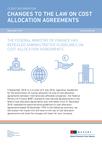
Changes to the law on cost allocation agreements
9 September 2018: In a circular of 5 July 2018, regarding “Guidelines for the examination of income allocation by way of cost allocation agreements between internationally affiliated companies”, the Federal Ministry of Finance (BMF) reacted to international developments in the field of cost allocation agreements and, with effect from 31 December 2018, repealed the administrative guidelines on cost allocation agreements dated 30 December 1999. In the following summary, we will explain the impact this will have on the use of cost allocation agreements and what the changes will mean for your company.
The administrative guidelines on cost allocation agreements, which have been in effect since 1999 1, set forth the revenue authorities’ view on the interpretation of the arm’s length principle in the context of pool agreements, in which internationally affiliated companies pursue joint interests for a longer period of time and provide and/or use pooled services.2 Profit markups on the shared costs in this context were not recognised for tax purposes.3 The existing interpretation was based on the rules on Cost Contribution Arrangements in Chapter VIII of the OECD Transfer Pricing Guidelines, as amended in 1995.
OECD transfer pricing guidelines amended in 2017
In Chapter VIII of the new version of the OECD Transfer Pricing Guidelines 2017, which forms part of the OECD/G20-BEPS project, the rules of interpretation of the arm’s length principle in the case of cost allocation agreements have been comprehensively revised. The changes essentially involve greater emphasis on an economic approach, a change in the allocation of risks among pool members and a fundamentally new assessment of the contributions to cost allocation agreements. While the focus was previously on the principle of cost-sharing, the revision shifts to a market-price-based assessment of the contributions of pool members.
This has given rise to discrepancies between the national provisions contained in the 1999 administrative guidelines and the international interpretation provided by the OECD regarding the treatment of cost allocation agreements. The current BMF circular of 5 July 2018 uses these differences as an opportunity to announce that the application of the provisions in Chapter VIII of the OECD Transfer Pricing Guidelines is now mandatory for national revenue authorities.
New administrative guidelines for financial years as of 31 December 2018
The 1999 administrative guidelines on cost allocation agreements will be repealed by way of the new BMF circular as of 31 December 2018. The new rules thus apply to financial years commencing after 31 December 2018. Cost allocation agreements concluded prior to the date on which the BMF circular was published (5 July 2018) will be assessed for a transitional period until 31 December 2019 under the old cost allocation rules.
As a result of the direct reference made to the OECD guidelines, largely redundant administrative guidelines will be eliminated. The modernisation of transfer pricing rules, however, gives rise to some changes which will have a substantial impact.
In this regard, the emphasis has explicitly shifted from a consideration solely based on costs to one which looks at the value creation of the individual contributions under cost allocation agreements. We can therefore assume that, in future, the profit mark-up made when calculating the contributions of pool members will have to be taken into account. In the case of significant contributions involving intangible assets, their value must be determined according to the arm’s length principle, e.g. using appropriate valuation methods. In the case of cost allocation agreements relating to research and development, in particular, calculating contributions of services purely on a cost basis is prohibited with immediate effect.
Further changes arise as a result of the increasing importance of mutual benefit when assessing cost allocation agreements. Thus, at the time of concluding a cost allocation agreement, the expected benefit for each pool member should amount to the arm’s length price which corresponds to their contribution to cost-sharing. In this regard, according to OECD recommendations, the benefit should be determined at the beginning of the allocation period which will generally only be possible using forecasts.
Since participants in cost allocation agreements will control the risks and bear any financial loss relating to their contributions, there may be shifts in respect of the admissibility of individual participants to cost allocation agreements. In addition, shared interests are essential for setting up a cost allocation pool. In case of research and development pools, in particular individual companies, may therefore be excluded from taking part in the cost allocation pool due to heterogeneous interests (e.g. purely financing companies).
More company audits expected
Past experience shows that cost allocation agreements are regularly the subject of company audits in Germany. In view of the current OECD developments, it may be assumed that they will become an even greater focus of attention in the future. Protracted discussions between tax authorities and tax payers are likely as regards the assumptions on which cost allocation agreements are based. In case of research and development pools in particular, we expect there to be an increased need for argumentation and documentation regarding the expected benefit and permissibility of participation by individual members of cost allocation pools.
Particular attention must continue to be paid to the documentation requirements 4 applicable to individual cost allocation agreements. Thus, the latter must be concluded in writing and are subject to extensive requirements regarding content. Special documentation requirements arise, in particular, from the Transfer Pricing Documentation Ordinance (GAufzV). Thus, the conclusion of a cost allocation agreement constitutes a so-called extraordinary transaction which is subject to abriged documentation requirements. In the context of master files, it is also obligatory to list cost allocation agreements relating to intangible assets.
Check and amend cost allocation agreements now!
Companies participating in existing cost allocation agreements should check these now as amendments are very likely to be necessary by 31 December 2019. The focus in this regard should be on the valuation of contributions, permissibility of membership, determination of the expected benefit and potential adjustment clauses and compensatory payments. Above all, in case of research and development pools, a higher administrative burden due to the new regulations may make this arrangement less practicable in the future. If the tax payer still plans to implement cost allocation agreements, it may be advisable, for the sake of legal certainty, to conclude a bilateral or multilateral Advance Pricing Agreement.
In case of further queries regarding the changes and the application of cost allocation agreements, please do not hesitate to contact the Transfer Pricing Team.
1 BMF Circular of 30 December 1999 “Guidelines for the examination of income allocation by way of cost allocation agreements between internationally affiliated companies” (“Cost allocation rule”), Federal Tax Gazette BStBl I 1999 p. 1122.
2 Of primary concern is the shared use of resources.
3 A distinction must be made between the pool agreements referred to here and cost allocation agreements made in the context of the provision of intra-group services that are based on actual exchange of services.
4 Section 90 (3), sentence 3 Tax Code (AO).




